| Tell a friend | Print version |
|---|
SEALs hunters
The night falls at one of the Navy bases. Several men wearing frog suits dive into the water from a motor boat stopped in the middle of the base basin. They dive deep and start exploring bottoms of the ships anchored at the roads.
It would took them a long time to cover great distances that is why they use electric diver-tugs that can drag a man under water in a certain direction at a rather good speed. Suddenly the divers stop and make rapid gestures to each other. A fraction of a second and the weapons are made ready. But the alarm is false. In some time the divers continue their way under water…
It would took them a long time to cover great distances that is why they use electric diver-tugs that can drag a man under water in a certain direction at a rather good speed. Suddenly the divers stop and make rapid gestures to each other. A fraction of a second and the weapons are made ready. But the alarm is false. In some time the divers continue their way under water…
 These words are about the servicemen of Combat forces with underwater diversionary forces and facilities (PDSS). For good reason neither station of the unit nor the people themselves serving in such special unit are to be talked in details. That is why it is interesting to get to know the facts that can be disclosed in the columns of the paper.
These words are about the servicemen of Combat forces with underwater diversionary forces and facilities (PDSS). For good reason neither station of the unit nor the people themselves serving in such special unit are to be talked in details. That is why it is interesting to get to know the facts that can be disclosed in the columns of the paper.
They are being commanded by experienced officer captain of the 2nd rank Valeriy S. who knows the techniques of combat swimmers from A to Z. Because of this the commanding officer is respected by everybody in the unit. The swimmers dispatch specific missions on protection of naval bases approaches, carry out visual monitoring of the harbors. For these purposes they use small crafts such as motor and rowing boats. The characteristic feature of swimmers’ service is both onshore and maritime operations. And the results in both environments should be perfect.
“Our main objective is not to let commando frogmen into the base", says unit commander.
 The servicemen are sure in operational efficiency of their equipment and the force of weapon but consider potential enemy with all solemnity as the underestimation of the enemy could cost dear.
The servicemen are sure in operational efficiency of their equipment and the force of weapon but consider potential enemy with all solemnity as the underestimation of the enemy could cost dear.
The stakes are high in underwater sabotage war. According to the experience of operations of foreign naval reconnaissance and sabotage groups in numerous NATO maneuvers, armed hostilities of Royal Navy during Falkland Crisis and US Navy in Persian Gulf the role of frogmen would increase greatly should a new war occurs. Such forces would pose serious threat to the ships in harbors and coastal facilities. In connection with this High Command of NATO Allied Naval Forces pay special attention to the training and practice of frogmen and their supply with the most sophisticated equipment and weapons.
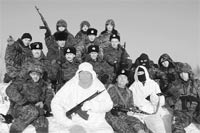 After the first Gulf War one would think ages passed but even in the United States the detailed reports dealing with the activities of Naval Special Forces were not published. The summary of commando participation in the notorious Desert Strom was tabled in Congress only. But the quality of their work can be judged by from the commando operations of those countries that requested help from US in training of such specialists.
After the first Gulf War one would think ages passed but even in the United States the detailed reports dealing with the activities of Naval Special Forces were not published. The summary of commando participation in the notorious Desert Strom was tabled in Congress only. But the quality of their work can be judged by from the commando operations of those countries that requested help from US in training of such specialists.
For instance in 1986 in Angolian port of Namibe as the result of multiple explosions two soviet commercial ships were damaged and Cuban vessel Havana due to four holes in the hull capsized and sunk. Also there were knocked out of action high-voltage power line and a section of a railroad and a fuel oil tank farm was destroyed. All this was the result of operations of three small sabotage groups deployed by a vessel anchored on the roads and flying colors of a neutral country.
Such classic examples from the history of usage of underwater sabotage forces can be given in any quantity. For instance few people aware that in January 1945 the Nazi special unit K attempted to carry out underwater attack against the ships in the harbor of Murmansk. However six 1-man midget submarine of Biber type (each could carry two torpedoes) gave under the severities of a northern climate and the raiders were forced to retreat.
Since that time the Northern Fleet now possessing brigades of nuclear-powered submarines and nuclear missile capability still remains in focus of Special Forces of various foreign nations. The numbers of such forces in US only according to official figures makes up about five thousand servicemen. Similar forces are already accomplished fact in Great Britain, Germany, Norway and some other countries. And the zone of “professional interest” of such units covers the Russian coasts of Barents and White Seas.
Along with this fact in recent years Northern Fleet Command has to consider the possibility of sabotage from terrorists.
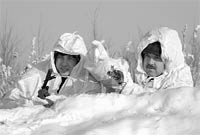 And so to say PDSS stays awake twenty four hours a day. They are ready at any time to dispatch a mission on defense of Fleet's base from any kind of commando, having in mind that in case of large scale military conflict the adversary would not only try to detonate the ships but to lay mines at navigable channel as well. All the more so today frogmen have available so many types of transportation means and weapons that they literally can choose specially designed means for any particular operation. They even have a nuclear-powered midget submarine at their disposal.
And so to say PDSS stays awake twenty four hours a day. They are ready at any time to dispatch a mission on defense of Fleet's base from any kind of commando, having in mind that in case of large scale military conflict the adversary would not only try to detonate the ships but to lay mines at navigable channel as well. All the more so today frogmen have available so many types of transportation means and weapons that they literally can choose specially designed means for any particular operation. They even have a nuclear-powered midget submarine at their disposal.
The more so US Navy SEAL commandos have in the inventory quick-firing guns - gloves with built-in firing devices for use in a fight at close quarters. Conventional black rubber frog suits were replaced by fireproof fabric and light-weight armor vests that have many pockets for reserve ammunition, gear and other sophisticated devices allowing commando to function independently.
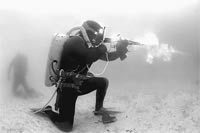 That is why the inventory of PDSS units has plenty of anti-sabotage “surprises” making possible timely detection of the enemy and ensures frustration of all efforts of enemy frogmen. Perfecting of this inventory is a daily concern of unit’s commanding officers and servicemen. Special attention of PDSS unit's experts is paid to the heavily embayed coast of the harbor. Some of the bays have convenient approaches from the coast side and the enemy can use this possibility to outflank underwater surveillance systems on base approaches. These very bays and underwater grottos while preparation for sabotage operations can be used by frogmen for delivery of containers with weapons, equipment, various demolition sets, and so on.
That is why the inventory of PDSS units has plenty of anti-sabotage “surprises” making possible timely detection of the enemy and ensures frustration of all efforts of enemy frogmen. Perfecting of this inventory is a daily concern of unit’s commanding officers and servicemen. Special attention of PDSS unit's experts is paid to the heavily embayed coast of the harbor. Some of the bays have convenient approaches from the coast side and the enemy can use this possibility to outflank underwater surveillance systems on base approaches. These very bays and underwater grottos while preparation for sabotage operations can be used by frogmen for delivery of containers with weapons, equipment, various demolition sets, and so on.
Combat training in the unit is taken very seriously. Daily exercises have become a tradition. Let’s take underwater fight technique for instance. At first sight there is not much of a difficulty. But if you think more carefully many questions arise. For instance how to use a knife underwater in water resistance environment. Therefore it is required to acquire special skills in order to overcome this resistance and turn the disadvantage into advantage. Training of diving skills is no less important side of their life. To bring up ordinary serviceman similar to foreign frogman it is required to teach him not only diving skills but other techniques appropriate as well.
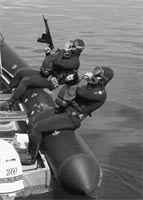 “The main thing for a serviceman is to get qualification of a diver. Usually it takes about two months. Everything on particular person,” says the commander.
“The main thing for a serviceman is to get qualification of a diver. Usually it takes about two months. Everything on particular person,” says the commander.
Average age in the unit is about thirty years. All fellows are rather young. There is no personnel turnover is the unit as it is. There were servicemen in the unit before drafted for certain term. The situation with these people was complicated by the fact that they were coming and going constantly. However these very people succeeded to participate in both Chechen campaigns and many of them were awarded. Since the year of 2000 contracted service was introduced. Although the start was rather tough. At first the fellows who officially discharged from the involuntary service stayed in the unit. Later those were recalled who finished the service and had good fitness conditioning. These were mainly the fellows who experienced from the flash points such as Chechnya, Abkhazia, Ossetia.
Today personnel selection work is performed by military enlistment offices. But it is more solid to enlist through personal contacts in other words trusted people. They won’t let down. Such an approach pays for itself as it allows avoidance of unforeseen situations that often occur in ordinary military units. Therefore commanding officer concentrates on service and combat training only.
After four years the unit is fully manned by contract servicemen. They are fully satisfied with the service and prolong contracts for ten years ahead. They feel themselves confident also with regard to material security. The servicemen have salary supplement for the service specificity as the risk should be paid for. And this is quite fair.
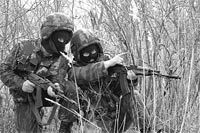 Daily routine of the unit includes practical exercises, firing exercises, training in the open waters, examination of ships’ bottoms, harbor basin, and facilities.
Daily routine of the unit includes practical exercises, firing exercises, training in the open waters, examination of ships’ bottoms, harbor basin, and facilities.
“We all go in for sport as we need to keep ourselves in perfect physical fitness. In our business this is everything,” says the commander.
In winter time the divers spend much of the time in a swimming pool working in lightweight diving outfit thus keeping the muscles in tone. In summer all the activities are carried out in harbor basin accordingly.
“In the water like our one have to work by feel only as the bottom is totally oozy. You stretch a hand and there is no bottom beneath but ooze everywhere. And additionally you work in complete darkness," says Valery S.
The special skills required are the sense of locality and ability to provide fire underwater. Absence of monophobia and claustrophobia go without saying.
Of course they use special weapons: SPP-1 underwater pistol, APS underwater assault rifle, and diver’s knives. By the way the named pistol and rifle are unique as they use propelling powder for shooting. There are new weapon samples, but they are not yet delivered to the unit. This very situation with the new weapons supply to the unit concerns the commander above all.
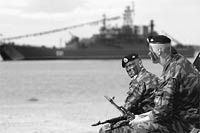 In the peacetime the fellows of the unit carry out rather unusual tasks. Although these assignments similar to their main duties. For instance recovery of explosive items. In case unexploded shell of World War II times is found at the bottom. The combat swimmers of PDSS unit recover it from the bottom, haul out to a safe location and explode it there. Should the shell is non-transportable it is detonated on site. The swimmers of the unit are also involved in searches of the missing people. It usually happens if due to some reasons the EMERCOM not capable to act or the case occurred in the area restricted for ordinary rescuers.
In the peacetime the fellows of the unit carry out rather unusual tasks. Although these assignments similar to their main duties. For instance recovery of explosive items. In case unexploded shell of World War II times is found at the bottom. The combat swimmers of PDSS unit recover it from the bottom, haul out to a safe location and explode it there. Should the shell is non-transportable it is detonated on site. The swimmers of the unit are also involved in searches of the missing people. It usually happens if due to some reasons the EMERCOM not capable to act or the case occurred in the area restricted for ordinary rescuers.
If all the planned is embodied the future of the unit will be bright. An advanced long-range plan for the unit is being developed. According to the plan the unit is to be redeployed to separate and permanent base. The base will be having own enclosed land area with training ground, support facilities and warehouses. The government should not save pocket with regard to such units.
Source: , Author: Alexander Lenin
Translation: RusNavy.com



